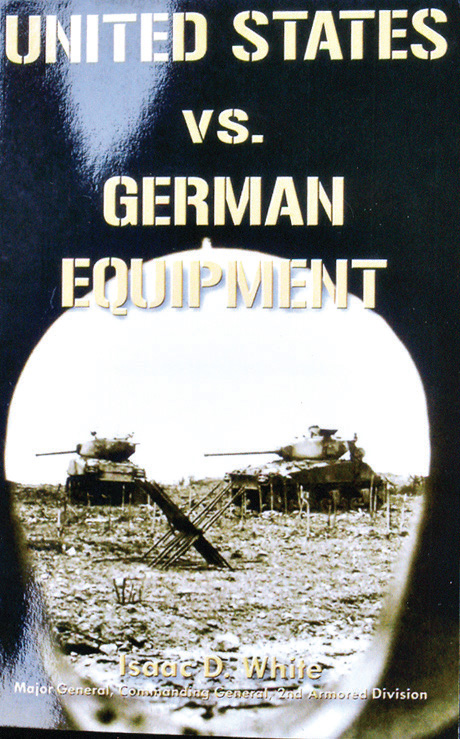Review by Larry S. Sterett | Contributing Editor
UNITED STATES vs. GERMAN EQUIPMENT, by Isaac D. White. ©2011. Published by Merriam Press, Elm St., Suite 3R, Dept. TGM, 133 Bennington, VT 05201. Price: $19.95, $3.00 plus shipping. Available direct, or at most bookstores.
This 172-page softbound volume, written by Maj. Gen. White , and prepared toward the end of World War II, was originally a mimeographed limited edition report with the title: A Report on United States vs. German Armor prepared for General of the Army Dwight D. Eisenhower, Supreme Commander, Allied Expeditionary Force.
 Following a short publisher’s note, this tome is divided into six parts. The first portion consists of letters between Eisenhower and White, with the second composed of a digest of opinions of officers and crews of the 66th and 67th Armored Regiments, relative to how our equipment compares to the enemy equipment. This is followed by a comparison of US and similar German equipment. Naturally, not everyone agreed, but for the most part, they did. The German Panzerfaust (bazooka) was superior to the American design. It was simple to operate, had greater penetrating effect and concussion, and was more accurate. Thus, American infantry and reconnaissance units were equipped with captured German bazookas whenever possible. The American M1 (Garand) autoloading rifle was far superior to the German Mauser 98k bolt action design, and the M2 .50 BMG had no equal among the German equipment. The US shelter half was not considered good—it leaked—and the poncho was recommended to replace the leaky raincoat. German footwear was considered better than that issued to US troops, and in spite of all the griping, US field rations were preferred over what the Germans had to eat. The Thompson was much better to carry than the M1 carbine, even though it weighed nearly twice as much.
Following a short publisher’s note, this tome is divided into six parts. The first portion consists of letters between Eisenhower and White, with the second composed of a digest of opinions of officers and crews of the 66th and 67th Armored Regiments, relative to how our equipment compares to the enemy equipment. This is followed by a comparison of US and similar German equipment. Naturally, not everyone agreed, but for the most part, they did. The German Panzerfaust (bazooka) was superior to the American design. It was simple to operate, had greater penetrating effect and concussion, and was more accurate. Thus, American infantry and reconnaissance units were equipped with captured German bazookas whenever possible. The American M1 (Garand) autoloading rifle was far superior to the German Mauser 98k bolt action design, and the M2 .50 BMG had no equal among the German equipment. The US shelter half was not considered good—it leaked—and the poncho was recommended to replace the leaky raincoat. German footwear was considered better than that issued to US troops, and in spite of all the griping, US field rations were preferred over what the Germans had to eat. The Thompson was much better to carry than the M1 carbine, even though it weighed nearly twice as much.
This reviewer had a neighbor who carried a Thompson while he served as a half-track driver under Patton from North Africa through Italy. He had been offered the Garand (no thanks), the M1911 (can hit anything with it) and finally the Thompson. As soon as the issued 50-round drum magazine was empty he discarded it in favor of the 20-round ‘sticks.’ “That 50-round drum took too long to load, and it wasn’t handy to carry a spare. Three or four of the 20-round box magazines were easier to handle.”
Personal convictions of individual officers and enlisted men of the 2nd Armored Division relative to the merits of German vs. American armor and equipment make up a large portion of the remaining text portion of this work. Overall, the crews interviewed seemed to feel American equipment was better than German equipment, except for tanks and the cannons/ammunition thereof. “We definitely need higher velocity ammunition.” “Our .50 caliber machine gun is tops.” “Our .45 caliber pistol is good.” “Our binoculars (all models) are definitely inferior to the Germans’ in power and durability.” “Most important of all, our armor plating is definitely inadequate.” (Frequently US tankers reported getting on target quickly, but having direct hits bounce off the hulls of the German tanks without penetrating.) “I have seen three American tanks knocked out by a Mark V tank at over three thousand yards. I have also seen a 105mm howitzer fired at 1,900 yards, which bounced off the enemy tank.”
Although the Germans had many tank models, only a captured Mark V had been tested and experimented with at the time this original report was presented. It’s characteristics, from speed to sights, including turret speed and trafficability, were detailed, followed by a summation of outstanding points (five, with foremost being heavy armor and high velocity gun) and weaknesses (a dozen, including heavy gasoline consumption, slow traversing speed of turret, lack of gyro-stabilizer, and lack of escape hatch) when compared to the US M4A3E8 tank.
The final 50 pages consist of captioned black and white photographs, including one of Eisenhower, and two sectionalized drawings of the M4A4 Medium, used by the British as the Sherman V. The majority of the nearly 100 photos are of various American and German tank models, half-tracks, and other tracked vehicles, with a few tired vehicles and some weapons shown. There is no index, or bibliography, or even an afterword.
This is an interesting small volume devoted to a subject not often seen in print. Comments made shortly after being in action tend to be more to the point, than those made decades after the fact. Nearly 70 years after the fact, they provide some insight to the what and why of that era.



